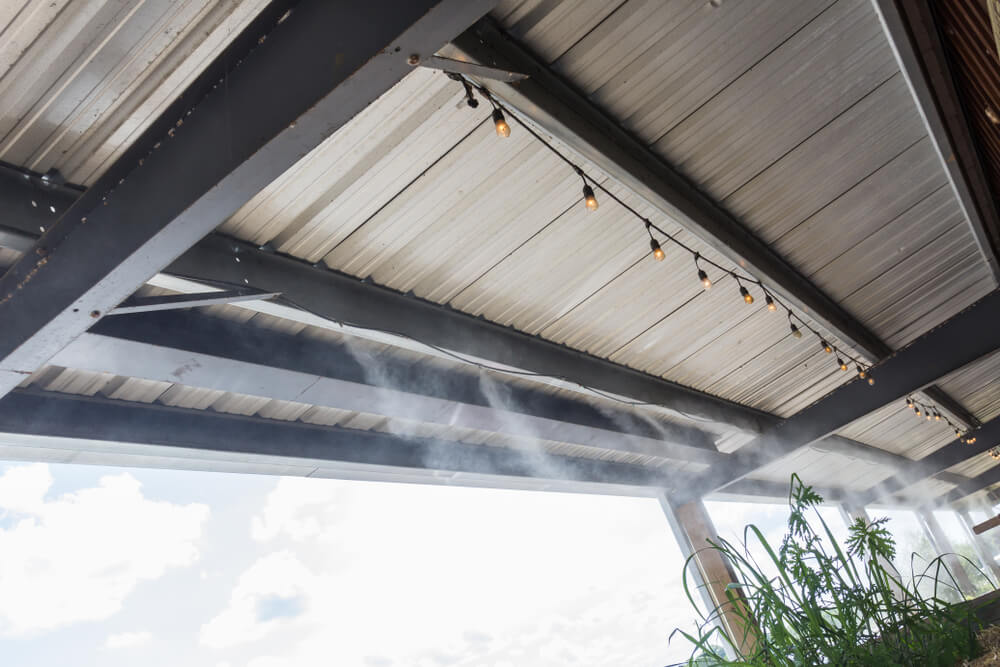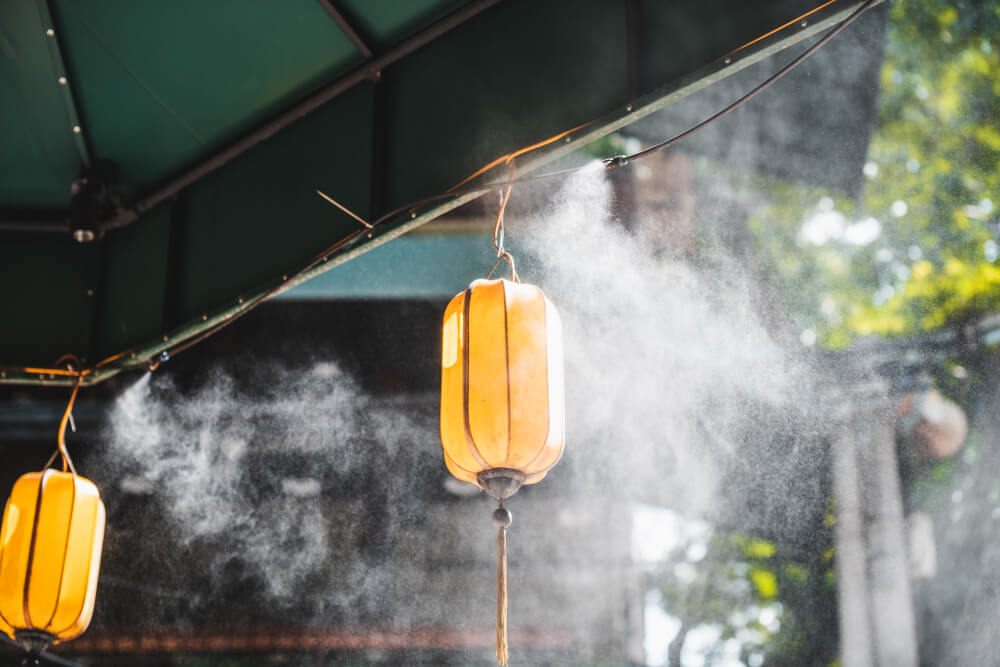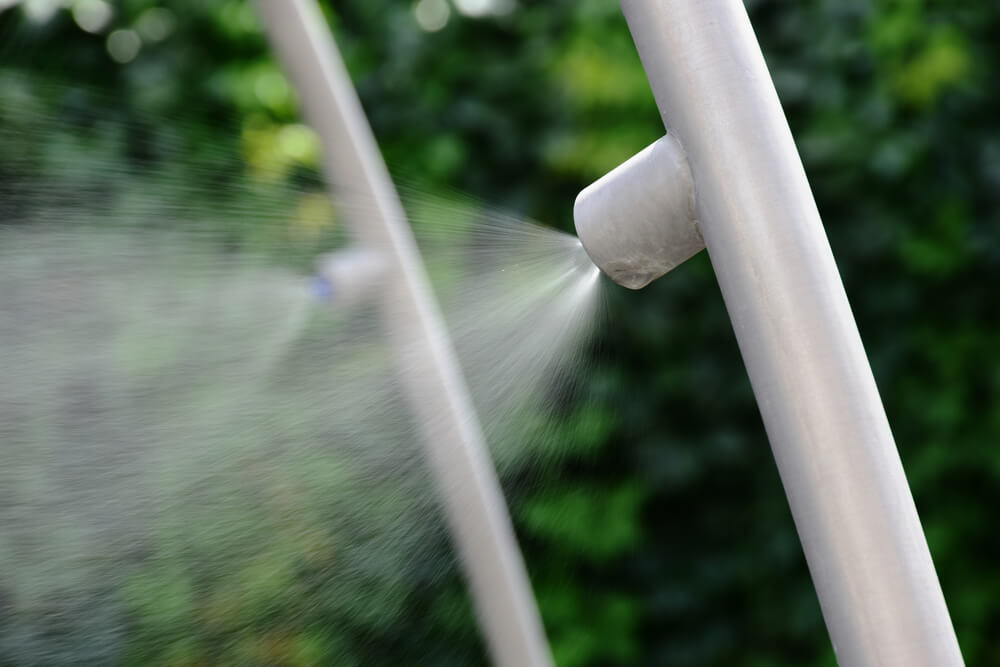Enhancing Outdoor Comfort: The Pros and Cons of Residential Misting Systems
Outdoor living spaces are becoming increasingly important for homeowners seeking comfort and relaxation in their own homes. As temperatures rise during the summer months, staying cool while enjoying the great outdoors can be challenging. This is where residential misting systems come into play.
You may have seen misting systems in zoos, farmers’ markets, outdoor restaurant patios, and other locations. These misting systems keep crowds cool while doing outdoor activities. They spray a cooling mist into the air, making the outdoors much more enjoyable.
In this comprehensive guide, we will delve into the science behind misting systems and then explore the pros and cons of outdoor misting systems for residential homes. We will also briefly discuss air conditioning misters and provide maintenance tips to ensure the longevity of your misting system.

The Science Behind Misting Systems: How They Cool the Air
Before diving into the advantages and disadvantages of misting systems, a brief explanation of how they work will allow you to better understand their pros and cons.
Misting systems create a fine mist of water droplets that are released into the air, where they quickly evaporate. This evaporation process absorbs heat from the surroundings, resulting in a significant cooling effect.
How Misting Systems Work: The Evaporative Cooling Process
Misting systems work on a simple yet effective scientific principle: the process of evaporative cooling.
What Is Evaporative Cooling?
Evaporative cooling is a natural phenomenon that occurs when a liquid—in this case, water—transforms into vapor by absorbing heat from its surroundings. This process is highly efficient in dissipating heat energy, resulting in a cooling effect. Misting systems leverage this principle to create a comfortable environment outdoors.
The Misting Process
Here’s a step-by-step breakdown of how misting systems work to cool the air:
- Water Source and Pressurization: Misting systems are connected to a water source, typically a hose or dedicated water line. The water is pressurized using a pump, creating a high-pressure environment within the system.
- Nozzle Dispersion: The heart of the misting system is its nozzles. These are strategically placed throughout the area you want to cool, whether it’s a patio, outdoor seating area, or garden. The high-pressure water is forced through these nozzles.
- Mist Formation: As the pressurized water exits the nozzles, it is released as a fine mist of tiny water droplets. These droplets are so small that they are often referred to as “micron-sized.”
- Evaporation: The misted water droplets are suspended in the air, creating a microenvironment of tiny water particles. As these droplets are exposed to the surrounding warm air, they quickly absorb heat energy from the atmosphere.
- Heat Absorption: In the process of evaporation, the water droplets absorb thermal energy (heat) from the surrounding air. This heat energy is used to convert liquid water into water vapor.
- Cooling Effect: The absorption of heat by the water droplets causes the air temperature in the immediate vicinity to drop significantly. This cooled air is then circulated throughout the outdoor space, creating a comfortable and refreshing atmosphere.
Efficiency and Cooling Capacity of Misting Systems
The efficiency of misting systems in cooling the air depends on several factors, including:
- Water Quality: The quality of the water used in the misting system can affect its performance. Water with a high mineral content can lead to nozzle clogs and reduced effectiveness.
- Nozzle Design: The design and quality of the misting nozzles play a crucial role. High-quality nozzles create a finer mist, which increases the surface area of water exposed to the air and enhances the cooling effect.
- Pressure: The pressure at which the water is forced through the nozzles is a critical factor. Higher pressure results in smaller water droplets, which evaporate more quickly and efficiently.
- Humidity Levels: Misting systems are most effective in dry or low-humidity conditions. In very humid environments, the cooling effect may be less noticeable because the air is already saturated with moisture.
- Proximity: Misting systems work best when you are in close proximity to the misted area. They are ideal for cooling specific outdoor spaces like patios, decks, or seating areas.
Pros of Residential Misting Systems

Some of the advantages of misting systems are:
- Efficient Cooling: The primary advantage of misting systems is their ability to cool outdoor spaces efficiently. By reducing the surrounding temperature, they create a comfortable environment even during scorching summer days.
- Enhanced Outdoor Living: Installing a misting system on your residential patio can transform it into an oasis of comfort. It allows you to use your outdoor space more frequently, whether it’s for lounging, dining, or entertaining guests.
- Energy Savings: Misting systems consume significantly less energy compared to traditional air conditioning units. They work by using water, which makes them an eco-friendly and cost-effective cooling solution.
- Dust and Allergen Reduction: Misting systems can help reduce dust and allergen levels in your outdoor area by trapping particles in the mist droplets and bringing them to the ground.
- Insect Repellent: The mist created by these systems can act as a natural insect repellent, keeping pesky bugs at bay during your outdoor activities.
- Plant Health: Misting systems can benefit your garden or outdoor plants by providing consistent moisture, especially in arid regions.
- Pet Safety: Dogs that overheat easily can enjoy the outdoors longer with a misting system to keep them cool.
Cons of Residential Misting Systems
- Initial Cost: One of the primary drawbacks of misting systems is the upfront cost. Quality systems can be quite expensive, including installation.
- Water Consumption: Misting systems require a steady supply of water, which can lead to increased water bills. However, they are generally more water-efficient than traditional sprinklers.
- Maintenance Needs: These systems require regular maintenance to prevent clogs and ensure proper functioning. Neglecting maintenance can lead to issues such as nozzle blockages.
- Humidity Levels: While misting systems can be a lifesaver during dry spells, they can raise humidity levels in the immediate vicinity. This might not be suitable for everyone, especially in already humid regions.
- Water Spots & White Mineral Dust: The fine mist can leave water spots or white mineral dust on outdoor furniture and surfaces, requiring additional cleaning.
- Limited Cooling Range: Misting systems are most effective in close proximity. They may not be suitable for cooling large outdoor areas unless multiple systems are installed.
How Well Do Patio Misting Systems Work?
Misting systems work on the same evaporative principle as Evaporative Coolers, also known as “swamp coolers.” These coolers can reduce air temperature by 15 to 40 degrees Fahrenheit, which is then redirected into the home.
Misting systems have been recorded to drop ambient temperatures by as much as 30 degrees Fahrenheit with the right conditions. They work most effectively in low-humidity areas.
Maintenance Tips for Your Misting System

Proper maintenance is crucial to ensure your misting system remains effective and reliable. Here are some maintenance tips to keep your misting system in top condition:
- Regular Cleaning: Clean the nozzles and lines to prevent clogs. Soak the nozzles in white distilled vinegar for six minutes to dissolve mineral buildup. Use a soft brush or compressed air to remove debris. During regular use periods, nozzle cleaning may be necessary once a month to prevent them from clogging.
- Check for Leaks: Inspect the system for leaks or damaged hoses. Address any issues promptly to avoid water wastage.
- Water Hardness: Ensure that your water source has a system in place to reduce or remove minerals in the water and check that the system is working correctly.
- Winterizing: If you live in an area with freezing temperatures, it’s essential to winterize your misting system to prevent damage from ice formation. Ensure there is no water in the system, or take the system down for the winter.
- Professional Service: Consider hiring a professional to perform routine maintenance and check the system’s overall condition.
Air Conditioning Misters: A Brief Overview
Air conditioning misters, sometimes known as HVAC misters, are a specialized form of misting system integrated with your home’s air conditioning system. They work by cooling the air around the condenser coil of your outdoor HVAC unit, resulting in more efficient and cost-effective cooling throughout your home.
Some air conditioner misting systems claim to reduce energy consumption by as much as 20 percent. While there has been some proven success in these systems, there are also some serious drawbacks.
If the water the misters use has minerals in it, the mist will be sucked into the condenser coils and will evaporate, leaving behind mineral dust. As the dust builds up, it heavily cuts into your AC’s energy efficiency by making it harder to effectively exhaust heat.
Additionally, while air conditioners are designed to handle some rain, they are not designed to be consistently drenched in a wet mist. This moisture creates huge issues with corrosion, which significantly reduces the lifespan of your AC.
Air conditioner manufacturers are always looking for ways to improve the efficiency of their AC units. Even with water filters, de-ionization, and other processes for removing minerals from the water, air conditioner manufacturers have found there are far too many problems with the concept to make it a standard feature.
The general consensus on pre-cooling your outdoor AC units with a misting system is that it will give you short-term efficiency at the cost of long-term performance.
Residential misting systems offer an effective solution for beating the heat and enhancing outdoor living spaces. While they come with their share of pros and cons, the benefits of improved comfort and energy savings outweigh the drawbacks of frequent maintenance for many homeowners.
If you are interested in installing a patio misting system in Lexington or Louisville, Kentucky, contact Dauenhauer to learn more.